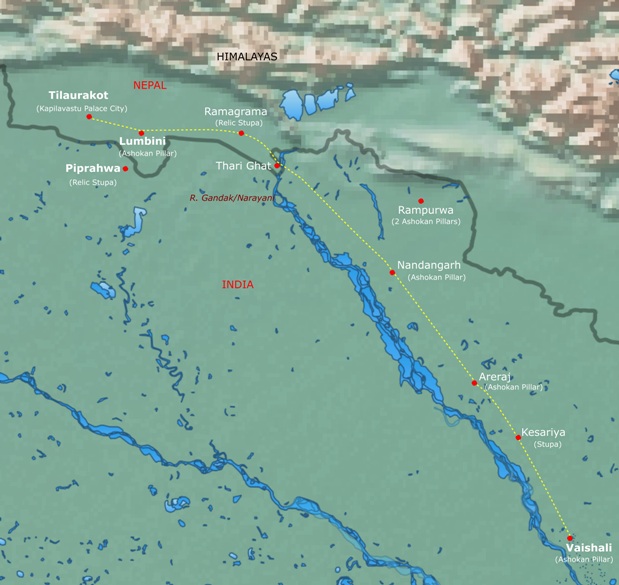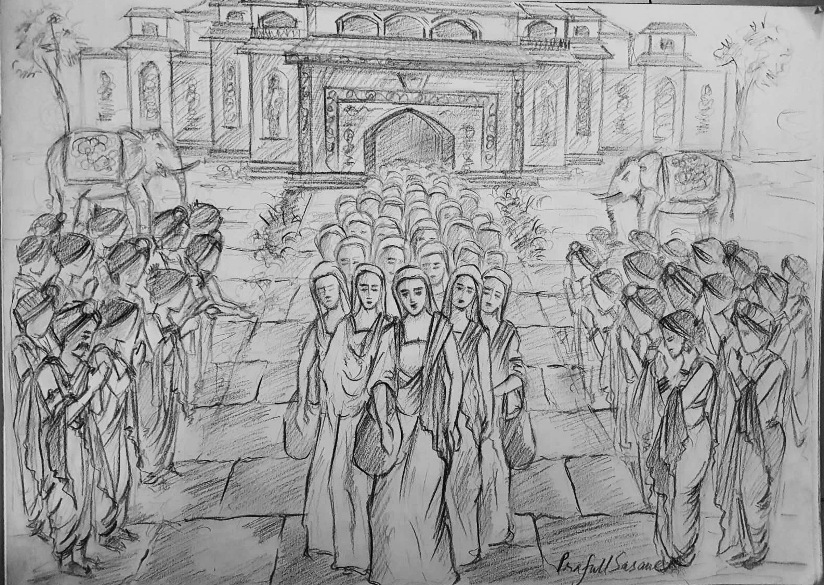Tracing the Footsteps of Resilience: Mahaprajapati Gautami and the 500 Shakyan Women’s Epic Journey for Gender Equality in Buddhism

Deepak Anand
 One of the lesser-known but very inspiring stories in the history of Buddhism is the story of Mahaprajapati Gautami and her Foot Journey along with 500 Shakya women to Vaishali to convince the Buddha to admit them into the sangha. This 300 km epic journey of Mahaprajapati and 500 Shakyan women in the 6th BCE from Kapilavastu to Vaishali is a joint legacy of India and Nepal.
One of the lesser-known but very inspiring stories in the history of Buddhism is the story of Mahaprajapati Gautami and her Foot Journey along with 500 Shakya women to Vaishali to convince the Buddha to admit them into the sangha. This 300 km epic journey of Mahaprajapati and 500 Shakyan women in the 6th BCE from Kapilavastu to Vaishali is a joint legacy of India and Nepal.
Mahaprajapati and Mahamaya were sisters belonging to the republican clan of Koliya in the foothills of the Himalayas. Both the sisters were married to the Shakyan king Suddhodana of Kapilavastu. When Mahamaya died, seven days after giving birth to Siddhartha, the Buddha-to-be, Mahaprajapati, raised the infant prince. One year into his enlightenment, the Buddha, on an invitation from his father, King Suddhodana, visited Kapilavastu. The Buddha during his stay at Kapilavastu gave sermons to the Shakyans. Mahaprajapati also participated in these teachings.
Four years later, the Buddha revisited Kapilavastu to resolve the water-sharing dispute between the Koliyas and the Shakyas. This visit provided Mahaprajapati an opportunity to share her yearning to join the sangha with the Buddha. The Buddha declined the proposal of Mahaprajapati to join the Buddhist order as a nun. This however didn’t daunt the spirit of Mahaparajapati. She resolved to follow the Buddha to Vaishali and present her case once again.

500 Shakyan women led by Mahaprajapati shaved their heads, donned the monastic robes and set out barefoot on a 300 km foot journey to Vaishali, where the Buddha was doing his rainy season retreat. A large part of this 300 km-long route runs parallel to the foothills of the Himalayas. In the rainy season, many small and wide rivers emanating from Himalayan foothills intercede on this path. After days of walking, the Shakyan women arrived at Vaishali. They were exhausted, their feet wounded but this didn’t dampen their spirits. They met the Buddha at Kutagarasala in Vaishali. Their repeated requests did not yield any results. Yet they didn’t lose hope. Shakyan women then met Ananda and requested that he put forth their request to the Buddha. After some hesitation, the Buddha allowed Mahaprajapati and 500 Sakyans into the sangha. The Buddha’s consenting to establish a bhikkhuni sangha was truly a historic step. Probably, this was the first women’s institution in known history that has a glorious continued history, and immense contributions, since its inception at Vaishali more than 2600 years ago.
The 300 km long Mahaprajapati Renunciation Trail touches some of the most iconic Buddhist monuments like Lumbini, Ramagrama, LauriyaNandangarh, Areraj and Kesariya in India and Nepal. It is to be noted that Vaishali is also important for Bhikkhuni Sangha because Mahaparajapati and 500 Sakyan nuns attained Parinirvana in Vaishali. 7th CE Buddhist monk scholar saw a stupa in the neighbourhood of the Ashokan Pillar site of Kolhua to mark the Parinirvana of Mahaprajapati.
There is a need to commemorate and celebrate the joint Buddhist legacy of India and Nepal. Revival of the Mahaparajapti RenunciationTrail shall be an acknowledgement and celebration, of equal opportunity for all and no discrimination in the name of gender. Let us not forget, that the arduous journey taken by 501 Sakyans 2600 years ago continues today for women seeking true sangha, respect, and full ordination.
(The writer is a Buddhist scholar)






